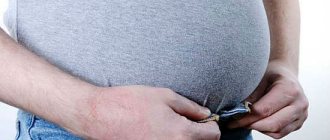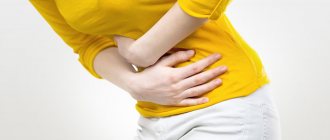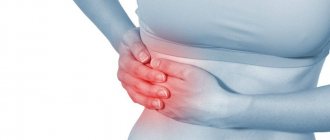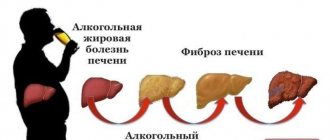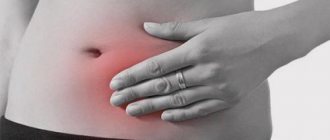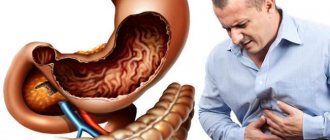Pain in the right side under the ribs is a rather alarming symptom, since it most often occurs during the course of any disease. People of different ages and genders are susceptible to this unpleasant clinical manifestation. In the vast majority of situations, pathologies from the gastrointestinal tract lead to the appearance of pain, but this does not at all exclude the possibility of its occurrence when other segments are affected.
Why does it sting in the lower abdomen on the right?
In this area of the abdomen there is the ascending part of the large intestine, loops of the small intestine, appendix, peritoneum, and partially the ureters. If stabbing pain suddenly appears in the right side and increases, most likely there is an acute pathological process:
- appendicitis (inflammation of the appendix);
- renal colic (is a painful attack that develops due to the passage of stones through the ureters during urolithiasis);
- intestinal obstruction;
- death of part of the intestine due to thrombosis of mesenteric vessels;
- pinching of internal organs in an inguinal hernia.
If the right lower abdomen stings periodically, then the following diseases should be suspected:
- colitis (inflammation of the ascending colon);
- enteritis (acute or chronic inflammation of the small intestine);
- disorders of the intestines, accompanied by fermentation processes, accumulation of gases, constipation;
- pyelonephritis or glomerulonephritis (inflammatory processes in different structures of the kidney);
- intestinal and kidney tumors.
In addition, periodic tingling in the lower abdomen can be caused by the presence of adhesions, which usually form where there was inflammation or surgery. To prevent the development of adhesions, patients are given drainage; they are advised not to linger after surgery so that inflammatory fluid does not stagnate in the abdomen; special medications and physiotherapy are prescribed.
Pain during pregnancy
Women who are pregnant may experience pain in the side when the uterus presses on the paired organs. If the liver is overloaded, the ureter will also suffer. During pregnancy, you should not worry about tingling or numbness on the right side, unless it is a constant phenomenon. A representative of the fairer sex may get a prick in the side due to physical activity, so it is worth limiting sports activities.
During pregnancy, progesterone increases the bile ducts, causing fluid stagnation in them, the symptom of which is a burning sensation in the right side. To avoid complications, a pregnant woman needs to seek help from a doctor, take blood and urine tests, undergo an examination and an ultrasound examination. If necessary, therapy will be prescribed. In case of any deviations, you should immediately consult a doctor.
Causes of tingling in the right side of the lower abdomen in women
All of the above causes of tingling in the right lower abdomen can occur in women. However, representatives of the fair sex also have their own specifics, due to the fact that in this area they have the uterine appendages (ovaries and fallopian tubes). Unpleasant sensations occur when these organs become inflamed. Moreover, most often this inflammation is chronic, so patients complain that they periodically have sipping and tingling on the right side above the pubis. In addition, pain in the right side below may manifest itself as a right ovarian cyst, polycystic disease, or malignant neoplasms of the appendages.
Rupture of the tube during a progressive ectopic pregnancy and apoplexy (violation of the integrity) of the ovary are diseases requiring emergency surgical care. With them, the right lower abdomen may also tingle, but only at the beginning of the development of the pathology. Very soon the pain becomes unbearable, and other symptoms of the disease appear - dizziness, drop in blood pressure, etc. If tingling in the lower abdomen occurs during a normal pregnancy, it is necessary to exclude the threat of miscarriage.
Tingling in the right side of the lower abdomen may accompany ovulation, which occurs in the right ovary. Normally, there should be no painful sensations, but if the ovary is inflamed, its capsule thickens, which can complicate the process of releasing the egg. Therefore, if tingling occurs constantly in the middle of the cycle, it is advisable to visit a gynecologist and undergo an ultrasound. Even slight discomfort may indicate that something is wrong with the uterine appendages.
Causes of pain in the right hypochondrium
To find out the cause of this manifestation, patients need to undergo a comprehensive laboratory and instrumental examination. In addition, information obtained through activities carried out personally by the clinician is very important.
The right hypochondrium is the area that is located between the two lower ribs to the right of the conditional middle of the anterior wall of the abdominal cavity. If there is pain in the right side under the ribs, then this may be due to the internal organs located in this area. These segments include:
- liver;
- right lung;
- several sections of the large and small intestines;
- one of the diaphragm areas;
- right adrenal gland and kidney;
- gallbladder and bile ducts.
However, pain in this localization can also be associated with damage to other parts of the body, for example:
- heart and lungs;
- pancreas;
- muscle structures that are located between the ribs on the right;
- spine.
Thus, the main reason that acute pain occurs in the right hypochondrium can be represented by:
- acute course or exacerbation of chronic cholecystitis;
- the formation of stones in the gallbladder or bile ducts;
- peptic ulcer of the duodenum or stomach;
- renal colic;
- intercostal neuralgia;
- pancreatitis;
- acute inflammatory lesion of the appendix;
- chronic variant of diseases such as pyelonephritis, hepatitis and duodenitis;
- cirrhosis or fatty liver hepatosis;
- fractures of the right lower ribs;
- diaphragmatic hernia or strangulation.
You can get rid of pain in the right side using conservative methods, but it is not possible to completely eliminate this symptom without completely eliminating the pathological provoking factor.
Symptoms of liver disease
Like other vital organs, it is located in the abdominal cavity, namely in its upper right corner, under the muscular septum of the diaphragm. In shape it is an obtuse triangle with rounded corners, consisting of two lobes. The first lobe attaches to the anterior abdominal wall in the area of the right hypochondrium, the second lobe tapers to the left costal arch. Painful symptoms appear with liver disease on the right side of the upper abdomen. The main clinical manifestations of liver pathology may be:
- Discomfort and pain in the projection of the liver;
- Enlargement of the liver;
- General weakness and malaise;
- Headache;
- Impaired mental and thinking abilities;
- Increased skin sweating and swelling;
- Yellowness of the skin and sclera;
- Skin rash;
- Severe itching of the skin;
- Increased fragility of blood vessels and tendency to bleeding;
- Signs of hypovitaminosis;
- Stool instability, changes in the nature and color of stool;
- Increase in abdominal size;
- Increased venous pattern on the skin of the abdomen;
- Unmotivated weight loss;
- Bitterness in the mouth;
- Cracks on the surface of the tongue and its coating with a white or brown coating;
- Temperature reaction of varying severity.
Minor pain in the right hypochondrium in the form of aching pain, bloating and heaviness. Characterize a sluggish pathological process of inflammatory toxic or other origin. This type of pain in the liver is most likely caused by an increase in the size of the organ and overstretching of the liver capsule. Patients cannot clearly identify one pain point.
Heart failure
Heart failure is a disorder of the myocardium, resulting in congestion in the pulmonary and systemic circulation.
The disease leads to hypoxia of organs and the development of their edema. The liver is one of those organs that is primarily affected in heart failure. If the right ventricle of the heart is weak, there is a high probability that the blood deposited (stored) in the liver will occupy up to 70% of the entire organ, instead of the usual 35%. As a result, the fibrous membrane stretches, which causes severe pain.
Stomach
The stomach is the organ that is most susceptible to disease due to the incorrect lifestyle of many people. Usually the pain caused by his diseases is aching, shooting, cramping in nature.
Intestines
With intestinal diseases, pain is mainly felt in the lower abdomen, but if problems occur with the transverse colon, then severe pain is felt in the hypochondrium.
Problems in this intestine arise mainly due to inflammation or hereditary pathologies. Common causes of the disease are low physical activity, unhealthy diet, long-term and uncontrolled use of medications. As a result of all this, frequent constipation occurs and intestinal atony develops.
Toxins are not eliminated naturally, but are absorbed back into the intestinal walls and then diseases such as diverticulitis, colitis, polyp growths, and cancer develop.
Appendix
This is a known disease that involves an inflammatory process of the appendix. The disease can affect any person, any age group. It is necessary to have information about the disease in order to consult a doctor in a timely manner. It was believed that the appendix was an unnecessary part of the body.
The pain may be felt closer to the liver and can be confused with pain in the bladder and female organs. The process of inflammation of the appendix begins slowly, the appendix swells and a purulent process begins. If you do not immediately consult a doctor within 2 days, the appendage may rupture and a purulent mass may enter the abdominal area. Other signs include:
- Weakness;
- Chills;
- A white and yellow coating is visible on the tongue;
- No appetite;
- Low temperature 37-38;
- Be sick;
- Trembling throughout the body.
The vermiform appendix is removed surgically. At the present stage, such operations are performed laparoscopically, without incisions. The degree of inflammation of the appendix before surgery plays an important role; the lower it is, the faster the patient’s recovery. During the postoperative period, water procedures are prohibited; you must rest and follow the doctor’s recommendations.
Pyelonephritis, kidney stones
Among all genitourinary diseases, kidney pyelonephritis is the most dangerous. Every year, about 1.3 million patients with pyelonephritis are registered in Russian outpatient practice. Difficulties in diagnosing the disease in women are associated with polymorphic symptoms, which are also characteristic of other female diseases.
Untimely diagnosis and delayed treatment can lead to irreversible consequences, so every woman needs to know what pyelonephritis is, how to diagnose it and, most importantly, how to treat pyelonephritis. Appears in a healthy organ as a result of a urinary tract infection. The acute course of the disease is characterized by the following 8 main symptoms:
- Temperature rises to 37-39 degrees;
- increased sweating;
- loss of appetite;
- nausea, vomiting;
- sharp or dull pain in the lumbar area;
- weakness;
- headache;
- difficulty urinating, pus or blood in the urine.
With a correct diagnosis, treatment for acute uncomplicated pyelonephritis is successful in most cases; cases of recurrent disease occur rarely. Untreated acute pyelonephritis becomes chronic. The duration of the disease is 3 months from the moment of diagnosis.
Ureters
The ureters are located between the kidneys and the bladder. Their purpose is to remove urine by contracting the walls. The disease of this paired organ can be either congenital or acquired.
Basically, the disease is inflammatory in nature, due to infection entering the organ. In addition, benign or malignant tumors can form in the ureter. Tuberculosis or cystic degeneration of the organ walls is less common.
The main symptoms of ureteral damage:
- pain in the lumbar region, which is equally intense throughout the day;
- pain when urinating;
- the occurrence of colic due to the presence of a calculus (stone) in the ureter;
- increased urge to empty the bladder;
- increased body temperature;
- weakness, drowsiness;
- change in the color of urine, the appearance of blood, pus, or flaky particles in it.
Gallbladder
The gallbladder is a small but very important organ that stores bile, which is necessary for processing food in the intestines.
The main pathologies of this organ include:
- cholecystitis - inflammation of the walls of the bladder without the formation of stones;
- cholelithiasis is a disease that occurs due to a violation of bilirubin metabolism. Characterized by the formation of stones in the bladder itself, its ducts and liver;
- acute cholangitis is a complicated form of cholecystitis in which inflammation affects the bile ducts;
- dyskinesia is a disease due to which the tone of the bile ducts or bladder changes;
- cancer.
Characteristic symptoms of gallbladder disease:
- pain in the right hypochondrium;
- hepatic colic;
- weight loss;
- nausea;
- hypothermia.
If the cause is a disease of the musculoskeletal system
Often pain on the right occurs against the background of osteochondrosis of the thoracic spine. Discomfort is felt more strongly on the back and sides. Stitching pain accompanies degenerative lesions of the vertebral discs and pinching of the corresponding nerve roots. The condition is called intercostal neuralgia. The pain often worsens when inhaling, coughing, moving and turning the body. The patient characterizes it as a needle prick in a specific place.
Such pain can be distinguished by the absence of additional symptoms: intoxication, digestive disorders, heart rhythm disturbances. There may be a double sensation of pain - in the sternum and back at the same time.
Why does the lower abdomen on the right side sting in men?
Men, just like women, can suffer from inflammatory bowel diseases, digestive disorders, and urolithiasis. However, representatives of the stronger sex are more likely to develop an inguinal hernia than representatives of the weaker sex. This is due both to the anatomical characteristics of the male body and to the excessive physical stress that men often have to endure. In addition, in men, pain may radiate to the right lower abdomen due to pathological processes in the prostate and bladder. Pain in the lower abdomen on the right may be due to stretching of the abdominal wall muscles after sports training and weight lifting.
What to do at home
The main rule is that you should not try to treat tingling in the abdomen if the cause of this unpleasant sensation is not known. Enemas, laxatives, painkillers, and heating pads can only make things worse, especially if the tingling occurs suddenly and has never happened before.
If your stomach hurts for a long time, you need to lie down and assess how intense the pain is, what is causing its occurrence, and whether there are other symptoms (nausea, fever, diarrhea or constipation, urinary disorders). It is important for women to remember what day of their menstrual cycle they have, whether their periods are late, and whether sexual intercourse preceded the occurrence of tingling. It is also worth checking vaginal discharge to see if there is blood on the underwear. All this information will allow you to figure out what kind of health problem may be present, which specialist is best to contact, or whether it’s time to call an ambulance.
Do not wait for a scheduled doctor’s consultation, but call an ambulance in the following cases:
- If the tingling becomes severe, taking on the shape of a painful attack, and interferes with daily work or sleep.
- If the pain is accompanied by vomiting, fever, severe dizziness or loss of consciousness.
- If the expectant mother has a strong pain in the lower abdomen on the right side.
- If, against the background of tingling in the abdomen, bloody diarrhea occurs.
Diagnosis of shooting pain in the head on the right side
The Clinical Brain Institute specializes in the diagnosis and treatment of headaches. If it bothers you often or occurs with high intensity, it is recommended to consult a therapist. Based on the results of the examination and medical history, additional consultation with an ENT doctor, neurologist and other specialized specialists may be required. To determine the cause of headache, the following examination methods are prescribed:
- blood tests (clinical and biochemical) - will indicate an increase in the concentration of leukocytes (indicators of inflammation), an imbalance of microelements, an increase in glucose levels and other pathologies;
- MRI, CT of the brain is a modern technique, thanks to which you can obtain a three-dimensional image of the area under study, identify areas of ischemia, neoplasms, and blood supply pathologies;
- ECG (electroencephalography) - analysis of bioelectrical conductivity of nervous tissue;
- ultrasound examination of the vessels of the head and neck;
- special examination techniques by an otolaryngologist to exclude otitis media and other hearing diseases.
Timely and accurate diagnosis is the key to correctly prescribing a treatment regimen. At the Clinical Brain Institute you can undergo a full examination using modern equipment and get the most accurate results.
Which doctor should I contact?
A scheduled visit to the doctor is necessary if:
The tingling repeats periodically.- A tumor-like formation appeared in the groin.
- In addition to stabbing pain, there are problems with bowel movements or bladder.
- There is a connection between the occurrence of discomfort in the stomach and eating, drinking some drinks, intimacy, and physical stress.
- The pain is minor, but persists for more than 3 days.
- In women, pathological vaginal discharge (blood, admixture of pus, etc.) appeared against the background of tingling in the lower abdomen.
When tingling in the stomach begins after eating, you should consult a gastroenterologist. For women with abdominal pain, it is advisable to see a gynecologist. If tingling occurs constantly in the same place and is associated with physical activity, accompanied by the formation of a protrusion in the groin, you need to visit a surgeon. If the pain is localized more in the back (lower back), consultation with a nephrologist or urologist .
Zubkova Olga Sergeevna, medical observer, epidemiologist
36,882 total views, 1 views today
( 51 votes, average: 4.45 out of 5)
Diet after appendectomy
Mediastinitis: symptoms, diagnosis, treatment
Related Posts
Treatment methods
Doctors will select an individual treatment regimen that will help relieve not only the pain syndrome, but also its cause. Depending on the cause and nature of the headache, the patient’s age and the presence of concomitant diseases, the following techniques may be prescribed:
- drug treatment: for mild headaches, use non-steroidal anti-inflammatory drugs (Ibuprofen), as well as painkillers (Analgin);
- antibiotics - indicated for purulent otitis and other diseases that are accompanied by bacterial infection;
- physiotherapy - a course of procedures designed to improve blood circulation and innervation of certain areas;
- nootropics are substances that improve blood supply to the brain and are used as an addition to the main therapy regimen.
The Clinical Brain Institute provides treatment for headaches of various origins in inpatient or outpatient settings. Therapy is carried out under the supervision of specialists, with constant assessment of its effectiveness and the dynamics of the patient’s condition. Doctors warn that self-medication can be dangerous and lead to complications, so at the first symptoms it is important to seek medical help.


